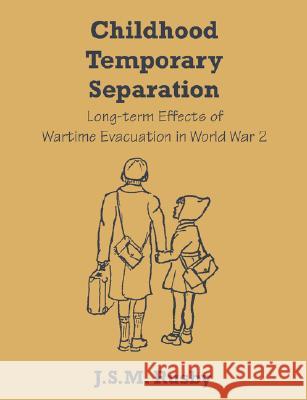Childhood Temporary Separation: Long-term Effects of Wartime Evacuation in World War 2 » książka
Childhood Temporary Separation: Long-term Effects of Wartime Evacuation in World War 2
ISBN-13: 9781599426570 / Angielski / Miękka / 2008 / 288 str.
Childhood Temporary Separation: Long-term Effects of Wartime Evacuation in World War 2
ISBN-13: 9781599426570 / Angielski / Miękka / 2008 / 288 str.
(netto: 143,58 VAT: 5%)
Najniższa cena z 30 dni: 140,97 zł
ok. 13-18 dni roboczych
Dostawa przed świętami

Darmowa dostawa!
This study investigates possible links between temporary separation from parents in childhood due to evacuation in World War 2 and later psychological development and adult relationships. The conclusions from an earlier qualitative pilot study had suggested that the developmental outcome of evacuation was perceived by those involved as lying on a continuum, at one extreme the experience was 'life-enhancing' and at the other it had left an 'emotional legacy' depending on an individual's experience. This present lifespan survey using self report questionnaires and involving 900 respondents from the county of Kent confirmed these perceptions and examined whether they were reflected by measures of mental health, marital history and adult attachment. The methodology employed univariate and multivariate analyses, including causal structural models of depression for both sexes, and involved both childhood and life-course mediating variables. In terms of mental health highly significant associations were found for the evacuation experience variables of Age at Evacuation and Care Received with the Incidence of Depression, Clinical Anxiety and Factor 2, Self-criticism, of the Depressive Experiences Questionnaire (Blatt et al., 1976), all in the predicted sense. Females were found to be particularly vulnerable to Clinical Anxiety if evacuated at 10-12 years with an incidence of 18%, accompanied by a high level of Self-criticism. Structural path models for the onset of depression confirmed that females not only had higher levels of Factor 1, Dependency, but were more vulnerable to these levels. Divorce rates were also highly associated with these same evacuation variables and multiple divorce rates for both sexes fell from 10%, if evacuated at 4-6 years, to 0% for those evacuated at 13-15 years. Adult attachment style measured by the self-report Relationship Questionnaire (Bartholomew & Horowitz, 1991) was also affected, with a fall in the Fearful style from 25% to 7% with increasing age at evacuation. Overall there was a tendency for male respondents to move to the Dismissive and females to the Fearful styles when secure attachment was lost. It is believed that such a lifespan development study, based on an 'experiment in nature' and involving an ageing cohort, has potential value in influencing future policy in the fields of mental health and social care.
This study investigates possible links between temporary separation from parents in childhood due to evacuation in World War 2 and later psychological development and adult relationships. The conclusions from an earlier qualitative pilot study had suggested that the developmental outcome of evacuation was perceived by those involved as lying on a continuum, at one extreme the experience was life-enhancing and at the other it had left an emotional legacy depending on an individuals experience. This present lifespan survey using self report questionnaires and involving 900 respondents from the county of Kent confirmed these perceptions and examined whether they were reflected by measures of mental health, marital history and adult attachment. The methodology employed univariate and multivariate analyses, including causal structural models of depression for both sexes, and involved both childhood and life-course mediating variables.In terms of mental health highly significant associations were found for the evacuation experience variables of Age at Evacuation and Care Received with the Incidence of Depression, Clinical Anxiety and Factor 2, Self-criticism, of the Depressive Experiences Questionnaire (Blatt et al., 1976), all in the predicted sense. Females were found to be particularly vulnerable to Clinical Anxiety if evacuated at 10-12 years with an incidence of 18%, accompanied by a high level of Self-criticism. Structural path models for the onset of depression confirmed that females not only had higher levels of Factor 1, Dependency, but were more vulnerable to these levels. Divorce rates were also highly associated with these same evacuation variables and multiple divorce rates for both sexes fell from 10%, if evacuated at 4-6 years, to 0% for those evacuated at 13-15 years. Adult attachment style measured by the self-report Relationship Questionnaire (Bartholomew & Horowitz, 1991) was also affected, with a fall in the Fearful style from 25% to 7% with increasing age at evacuation. Overall there was a tendency for male respondents to move to the Dismissive and females to the Fearful styles when secure attachment was lost.It is believed that such a lifespan development study, based on an experiment in nature and involving an ageing cohort, has potential value in influencing future policy in the fields of mental health and social care.











